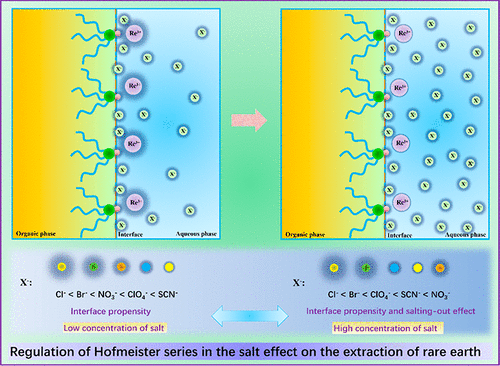Our official English website, www.x-mol.net, welcomes your
feedback! (Note: you will need to create a separate account there.)
Specific Salt Effect on the Interaction between Rare Earth Ions and Trioctylphosphine Oxide Molecules at the Organic–Aqueous Two-Phase Interface: Experiments and Molecular Dynamics Simulations
Langmuir ( IF 3.7 ) Pub Date : 2018-09-04 00:00:00 , DOI: 10.1021/acs.langmuir.8b02301 Pan Sun 1, 2 , Kun Huang 1, 3 , Huizhou Liu 1
Langmuir ( IF 3.7 ) Pub Date : 2018-09-04 00:00:00 , DOI: 10.1021/acs.langmuir.8b02301 Pan Sun 1, 2 , Kun Huang 1, 3 , Huizhou Liu 1
Affiliation

|
Understanding the essence of the specific salt effect on the enhancement of the transport of metal ions across the liquid/liquid interface during the process of solvent extraction is of crucial importance for the development of a new approach to extract and selectively separate various valuable metals from complex aqueous solutions. However, some abnormal experimental phenomena involved in the salt effect on the liquid/liquid solvent extraction could not be understood only from the conventional interpretation based on the salting-out ability of salt ions. The knowledge into the microscopic mechanism behind the specific salt effect was urgent. Herein, as an example, the effect of adding various salts on the extraction performance of rare earth ion Pr3+ using trioctylphosphine oxide (TOPO) as the organic extractant was investigated. It was revealed that the difference in the interface propensity of different salt anions enriched at the organic–aqueous two-phase interface played a crucial role in promoting the interaction of TOPO molecules with Pr3+ ions, despite the occurrence of the salting-out effect of those salt anions with the increase of their concentrations in aqueous solutions. The interfacial interaction mechanism obtained by molecular dynamics simulations revealed that both the interface propensity and the salting-out ability of the coexisting salt anions contributed to the enhancement in the extraction of Pr3+ into the TOPO organic phase. However, when the concentrations of coexisting salts in aqueous solutions were low enough, the extraction of Pr3+ was mainly dominated by the interface propensity of those added salt anions but not their salting-out ability. With the increase in the concentration of salts, the salting-out effect gradually became significant and, therefore, began to join with the interface propensity of salt anions to co-dominate the transport of Pr3+ ions across the liquid/liquid interface. The present study highlights the microscopic nature of the salt effect on promoting the extraction of rare earth ions and suggests that the interaction of organic extractant molecules with rare earth ions at liquid/liquid interface was dependent not only upon the salting-out ability of the coexisting salt ions but also their interface propensity.
更新日期:2018-09-04































 京公网安备 11010802027423号
京公网安备 11010802027423号